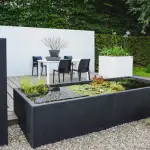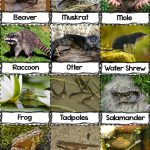Ponds are home to a diverse array of fascinating creatures that contribute to the ecosystem in unique ways. From tiny insects to larger amphibians, ponds teem with life that plays a vital role in maintaining the balance of nature. Let’s dive into the enchanting world of pond creatures and explore the variety of species that call ponds their home.

Credit: en.wikipedia.org
1. Tadpoles
Tadpoles are the larval stage of frogs and toads, and they are commonly found in ponds. These small, aquatic creatures have gills for breathing underwater and gradually undergo metamorphosis to develop into adult frogs. Tadpoles play a crucial role in the food chain, serving as prey for various predators such as fish and birds.
2. Dragonflies
Dragonflies are elegant insects that frequent ponds and other water bodies. With their vibrant colors and intricate wings, dragonflies are not only beautiful to observe but also serve as effective predators, feeding on mosquitoes and other small insects. These agile flyers are essential for controlling insect populations around ponds.
3. Water Lilies
Water lilies are iconic pond plants known for their beautiful floating leaves and fragrant flowers. These aquatic plants provide shelter for fish and other pond creatures, while their floating leaves offer shade and protection from the sun. Water lilies contribute to the overall health of ponds by oxygenating the water and reducing algae growth.
4. Pond Snails
Pond snails are small, slow-moving mollusks that play a crucial role in maintaining the ecological balance of ponds. These scavengers feed on algae and decaying plant matter, helping to keep the water clean and clear. Pond snails also serve as a source of food for fish and other predators in the pond ecosystem.
5. Frogs
Frogs are amphibious creatures that are commonly found in and around ponds. These vocal animals play a vital role in controlling insect populations by feeding on mosquitoes, flies, and other pests. Frogs also serve as indicators of the health of the ecosystem, with their presence or absence reflecting the overall condition of the pond.
6. Water Striders
Water striders are fascinating insects that can walk on the surface of the water due to their specialized legs and body structure. These agile predators feed on small insects that fall onto the water’s surface, contributing to the regulation of insect populations in ponds. Water striders are a common sight in calm, still waters such as ponds.
7. Newts
Newts are small amphibians that are often found in ponds and wetland habitats. These semi-aquatic creatures have smooth skin and a distinctive tail, making them excellent swimmers. Newts play a vital role in the pond ecosystem by preying on small invertebrates and helping to control insect populations.
8. Cattails
Cattails are tall, reed-like plants that grow in and around ponds, providing valuable habitat for various pond creatures. These plants offer nesting sites for birds, shelter for fish, and food for certain insects. Cattails also help to stabilize the shoreline and filter pollutants from the water, contributing to the overall health of the pond ecosystem.
9. Leeches
Leeches are aquatic worms that are often found in ponds and other freshwater habitats. While some people may find leeches unpleasant, these creatures play a crucial role in the ecosystem by feeding on dead plant material and serving as food for fish and birds. Leeches help to recycle nutrients in the pond environment, contributing to its overall balance.
10. Mosquito Larvae
Mosquito larvae are the immature stage of mosquitoes that require water for breeding. Ponds provide an ideal habitat for mosquito larvae to develop, making them a common sight in stagnant water. While mosquitoes can be a nuisance to humans, their larvae serve as an essential food source for many pond creatures, including fish and dragonflies.
11. Pond Skaters
Pond skaters, also known as water striders, are small insects that glide effortlessly on the surface of the water. These fascinating creatures use their specialized legs to stay afloat and hunt for prey such as mosquito larvae and small insects. Pond skaters are an integral part of the pond ecosystem, contributing to the regulation of insect populations.
12. Algae
Algae are simple, plant-like organisms that can be found in ponds, giving the water a greenish hue. While excessive algae growth can indicate poor water quality, algae play a vital role in the pond ecosystem by producing oxygen through photosynthesis. Algae also serve as food for certain aquatic creatures, contributing to the overall balance of the pond.
13. Waterfowl
Waterfowl such as ducks, geese, and swans are common visitors to ponds, where they feed on aquatic plants, insects, and small fish. These graceful birds contribute to the pond ecosystem by dispersing seeds, controlling insect populations, and adding to the overall biodiversity of the area. Waterfowl are a delightful sight for pond enthusiasts and nature lovers alike.
14. Pond Fish
Pond fish, such as koi, goldfish, and minnows, are popular inhabitants of man-made ponds and water features. These colorful fish add beauty and movement to the pond environment while helping to control insect populations and algae growth. Pond fish require proper care and maintenance to thrive, making them a rewarding addition to any pond ecosystem.
15. Water Beetles
Water beetles are aquatic insects that can be found in ponds, streams, and other freshwater habitats. These diverse insects come in various shapes and sizes, with some species being excellent swimmers and divers. Water beetles play a crucial role in the pond ecosystem by feeding on small invertebrates and serving as a food source for fish and other predators.
Credit: www.enchantedlearning.com
Conclusion
Ponds are dynamic ecosystems that support a wide variety of plant and animal life, each playing a unique role in maintaining the balance of nature. From tiny insects to larger amphibians, ponds are teeming with biodiversity that enriches the environment and provides valuable services to the ecosystem. By appreciating and understanding the diverse array of pond creatures, we can better protect and preserve these valuable habitats for future generations to enjoy.





